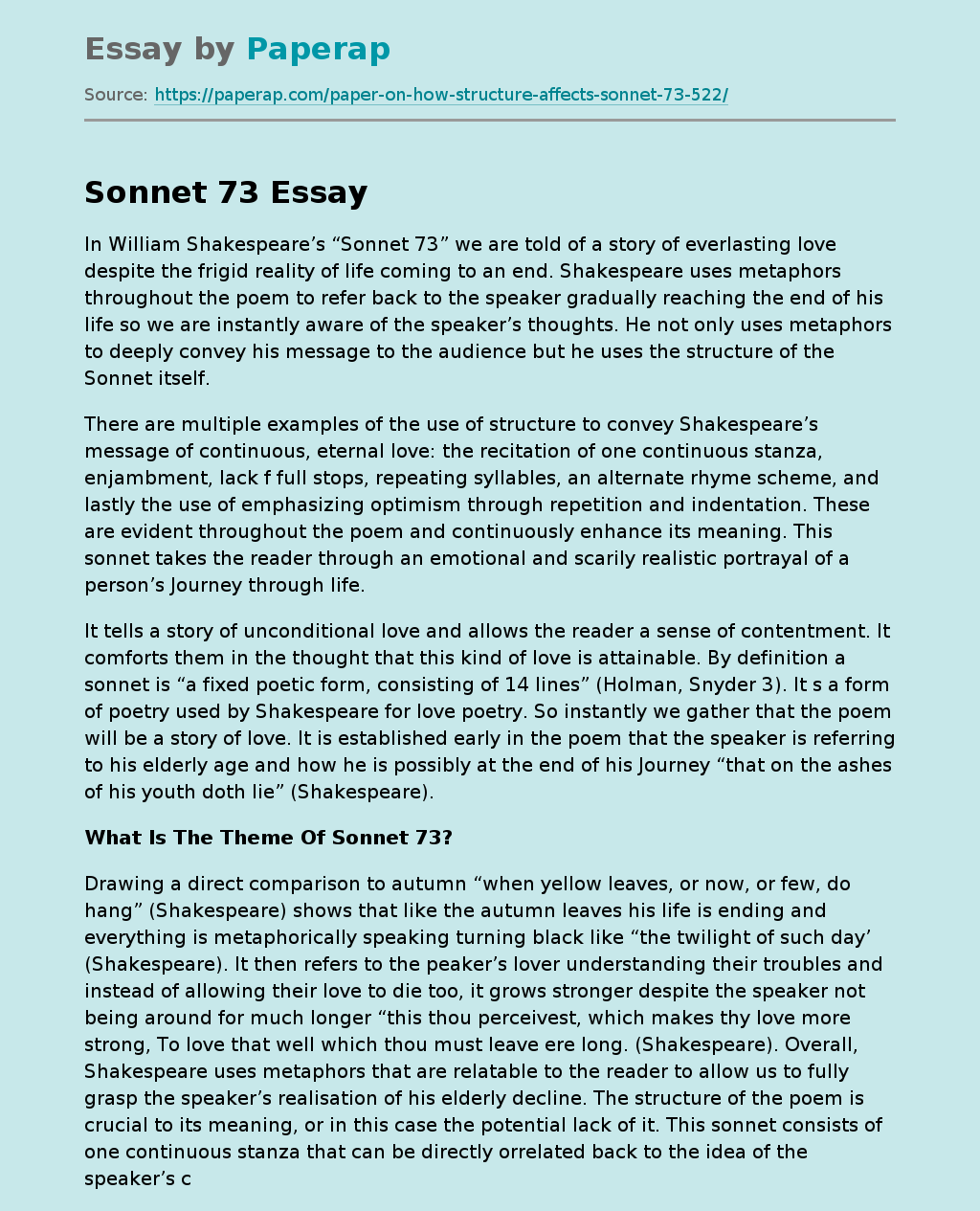What Is The Theme Of Sonnet 73?
In William Shakespeare’s “Sonnet 73” we are told of a story of everlasting love despite the frigid reality of life coming to an end. Shakespeare uses metaphors throughout the poem to refer back to the speaker gradually reaching the end of his life so we are instantly aware of the speaker’s thoughts. He not only uses metaphors to deeply convey his message to the audience but he uses the structure of the Sonnet itself.
There are multiple examples of the use of structure to convey Shakespeare’s message of continuous, eternal love: the recitation of one continuous stanza, enjambment, lack f full stops, repeating syllables, an alternate rhyme scheme, and lastly the use of emphasizing optimism through repetition and indentation.
These are evident throughout the poem and continuously enhance its meaning. This sonnet takes the reader through an emotional and scarily realistic portrayal of a person’s Journey through life.
It tells a story of unconditional love and allows the reader a sense of contentment.
It comforts them in the thought that this kind of love is attainable. By definition a sonnet is “a fixed poetic form, consisting of 14 lines” (Holman, Snyder 3). It s a form of poetry used by Shakespeare for love poetry. So instantly we gather that the poem will be a story of love. It is established early in the poem that the speaker is referring to his elderly age and how he is possibly at the end of his Journey “that on the ashes of his youth doth lie” (Shakespeare).
Drawing a direct comparison to autumn “when yellow leaves, or now, or few, do hang” (Shakespeare) shows that like the autumn leaves his life is ending and everything is metaphorically speaking turning black like “the twilight of such day’ (Shakespeare). It then refers to the peaker’s lover understanding their troubles and instead of allowing their love to die too, it grows stronger despite the speaker not being around for much longer “this thou perceivest, which makes thy love more strong, To love that well which thou must leave ere long. (Shakespeare). Overall, Shakespeare uses metaphors that are relatable to the reader to allow us to fully grasp the speaker’s realisation of his elderly decline. The structure of the poem is crucial to its meaning, or in this case the potential lack of it. This sonnet consists of one continuous stanza that can be directly orrelated back to the idea of the speaker’s continuous love. Just because the speaker is dying it doesn’t mean their love will die with him. Their love is real and will continue on after theyre gone.
Another example of this is how Shakespeare uses enjambment throughout the sonnet. It flows from one line to the next almost seamlessly and is broken up by a full stop only four times throughout its entirety. The lack of full stops in the poem accentuates the continuous flow and again enhances the meaning of the poem. Another way the structure enhances the meaning of the poem is by repeating syllables. In all 14 lines of the poem there are 10 syllables in every one. It doesn’t once vary. Throughout the poem there is no change, Just like the speaker’s love.
This never changing love builds on the continuous idea that was established earlier. Even something as substantially life altering as death, means nothing for this couple and that is the most empowering message in this poem. A great deal of “Sonnet 73” has a very cynical take on life “Death’s second self, that seals up all in rest. ” (Shakespeare). But in the final two lines we see a light at the end isn’t as demoralizing as the beginning of this poem makes out. Yes, death is a sad and scary prospect but it is something that we all come to accept.
Love on the other hand is the power of the spirit. It allows you to feel a depth of happiness no other emotion can allow you to feel. So it only makes sense that Shakespeare elaborates on this emotion by using an alternate rhyme scheme. It creates an almost song like effect in the poem which in turn is associated with happiness and often tales of love. Shakespeare used two different ways to show there are only small bursts of optimistic happiness in this sonnet. The poem is broken up by a phrase that is epeated twice “In me thou see’st” (Shakespeare).
Both times this phrase leads onto the lover trying to show the speaker the good she still sees in him. The speaker then returns back to the cynical mood of the sonnet. Shakespeare then restores all of the reader’s faith in love by finishing the somber tale with two lines “This thou perceivest, which makes thy love more strong, To love that well which thou must leave ere long” (Shakespeare). These two lines are so important to the overall message of the story. They ensure the reader that there is a chance of everlasting love and that it is attainable.
Because of its importance the two lines have been indented to draw attention away from the dismal story and emphasise the ending message. In this sonnet we read of a story that we all hope one day we ourselves will have the privilege of experiencing: an everlasting love. Shakespeare enhances his message of this love through the structure of this poem. The use of one stanza, enjambment, lack of full stops, repeating syllables, an alternate rhyme scheme and emphasizing optimism through repetition and indentation all reinforce the idea of continuous, never changing love and accentuate the emotions that can come with that.
What Is The Theme Of Sonnet 73?. (2019, Dec 05). Retrieved from https://paperap.com/paper-on-how-structure-affects-sonnet-73-522/

